



(Photos: Jonathan Maus)
“We’re definitely learning some lessons.”
— Scott Cohen, PBOT project manager
It’s been six weeks since the Portland Bureau of Transportation (PBOT) began grinding off pavement and laying down new lane striping as part of the North Rosa Parks Way project. Yet despite weeks of dry weather and no major controversy or pushback (at least that we’ve been able to confirm), the project is still not closed to being finished. Meanwhile, people who ride on the two-mile stretch between Martin Luther King Jr and Willamette boulevards are frustrated by incomplete striping and many people park their cars illegally in the new bike lanes.
At the end of May, PBOT posted an update that acknowledged the major elements of the project that remain: they haven’t even began on the sections from Delaware to Interstate and Williams to MLK; none of the promised, plastic delineator posts have been installed; no permanent “No Parking” signage has been added despite a major change in parking availability; many bits of pavement markings are incomplete; and a median island crossing at Villard has yet to be started on.
But here we are, nearly one month later, and there’s been little to no progress on those issues.
I realize there are many variables to street projects and I prefer to not chime in on a project until it’s 100 percent complete. But something feels odd about this one. Things are half-way done, as if crews just up-and-left for something else. Or worse, PBOT has hit a roadblock due to angry neighbors or some other bureaucratic hurdle. Also, the inconsistent striping exists without any caution or work-zone signs and people continue to park illegally in the newly marked bike lanes instead of the “floating” parking spots. Meanwhile, vulnerable road users are thrown into the mix and forced to adjust and survive.
Hoping to learn the latest, I jumped on a call today with PBOT Project Manager Scott Cohen and Public Information Officer Dylan Rivera. Here’s what I asked and what I learned:
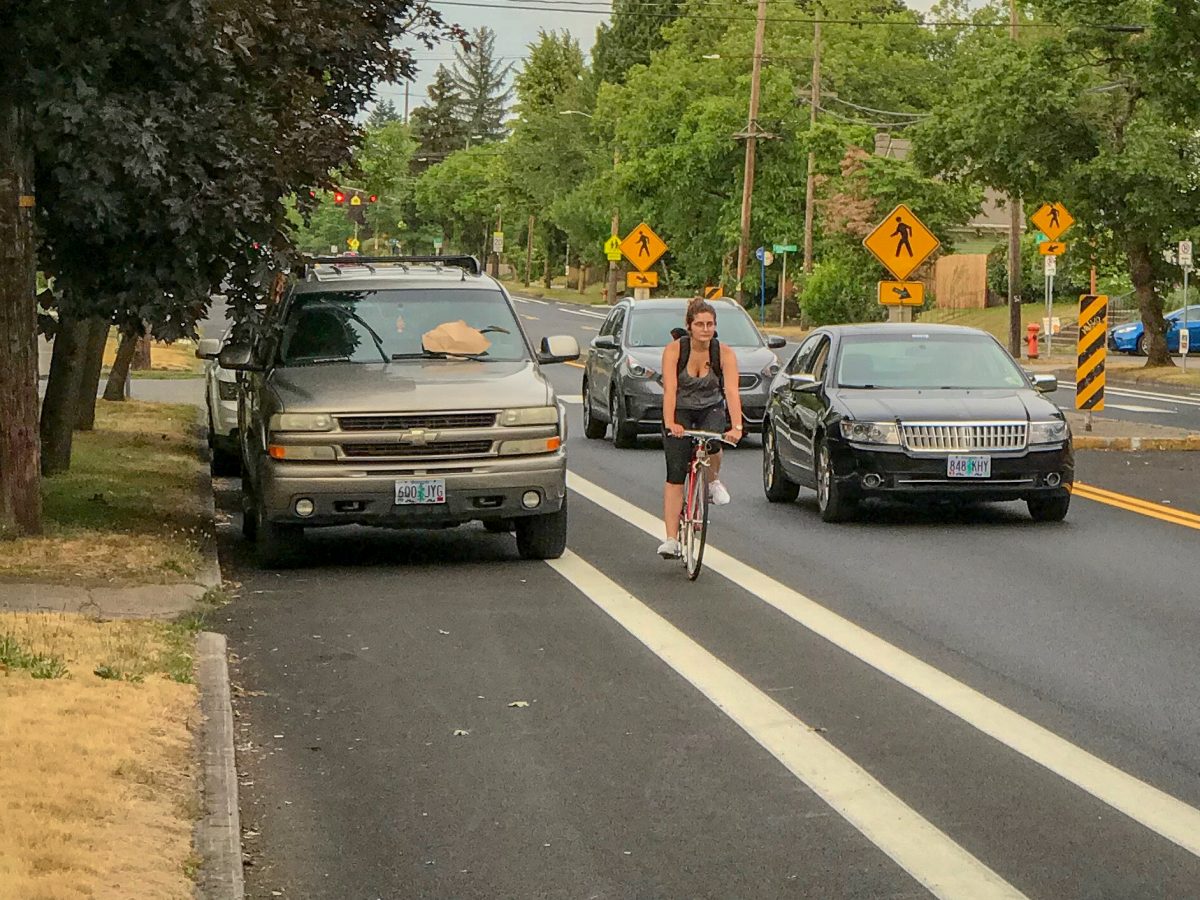


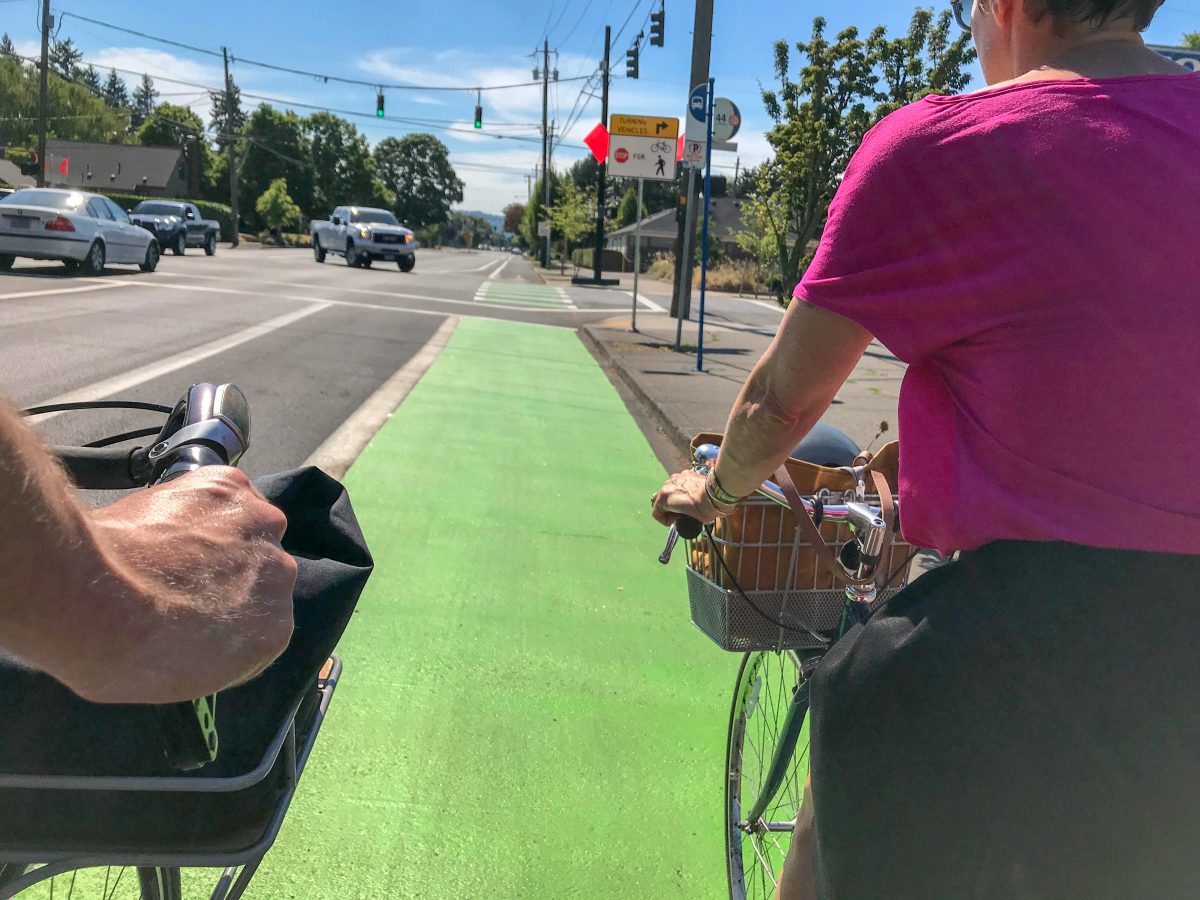
➤ What’s the status of the median crossing at Villard?
The design isn’t finalized yet. Cohen plans to attend the Arbor Lodge neighborhood meeting tonight to give them one last chance to provide feedback. One of the proposed designs would limit turning option for cars users. “All diversion is controversial,” Cohen shared today. “And there’s definitely been some outspoken residents about which design should move forward.” Cohen has the insane Lincoln/Harrison neighborhood meeting seared into his memory and doesn’t want a repeat. “I want the neighborhood association to be looped in.” To help calm hearts and minds, Cohen has sent a letter to everyone who lives on Villard near Rosa Parks, “To make sure everyone feels included.” After tonight’s meeting Cohen said PBOT will be ready to move forward on the final design and construction of the median.
➤ Why are two huge sections of the street still untouched?
With some sections already repaved and restriped, it’s awkward for everyone to have two sections with the old configuration. Cohen says the reason for this is because these sections have newer pavement and the usual machine PBOT uses to grind off striping damages the surface. He doesn’t want to leave bumps (think of the bumps left on Broadway downhill toward Hoyt), so they decided to contract with a private company that uses a water-based method of striping removal. That work has been scheduled and Cohen said it should be done, “In weeks or months.”
➤ Where are the plastic delineator posts you promised us?
Cohen said nearby residents told PBOT they were worried rows of white, plastic wands would make Rosa Parks feel less like a neighborhood and more like a highway. The location of this project (in a neighborhood) is much different than the typical downtown or commercial contexts where PBOT usually installs plastic wands. “Generally, the protected bike lane is wanted,” Cohen explained today, “But the neighbors we heard from want something besides what we typically do [plastic wands].” Because of this feedback, PBOT sought and received additional funding to use something else as the protective material in the buffer zones. Cohen didn’t tell me what exactly it would be because they’re still getting feedback. There are some locations where PBOT is moving ahead with plastic posts ASAP: Where there’s new floating parking spots, they plan to install posts with parking signage on them. Those should be installed very soon.
Advertisement
➤ Why is some of the striping still not finished?
I didn’t get a clear answer for this from either Cohen or Rivera. Cohen said the City’s two striping crews (one for the east side and one for the west side) are very busy this time of year. Rivera added that, “Striping work is in high demand, they [crews] have a million demands on their time and they’re trying to address as much of that as possible.” Rivera added that even though the striping is different from block-to-block, riders should just follow what’s there.

➤ Where’s the bus island that’s supposed to be installed on southwest corner of Albina intersection?
PBOT has striped this location and created the space for a future island, but as you can see in the photo, bus operators still pull all the way over into the bike lane to service the stop on the corner. Cohen says the island hasn’t been installed yet because they’re still, “Working with TriMet on how best to move forward.” In the meantime, PBOT plans to test modular platforms (which he described are like “big LEGOs”) at two locations in the similarly designed bike lanes of SE Morrison. Cohen says they’ll analyze how those work and see if it’d make sense to use them on Rosa Parks. PBOT hasn’t done many floating bus islands, so they seem hesitant to pour expensive concrete before knowing for sure how bus operators and riders will use it.
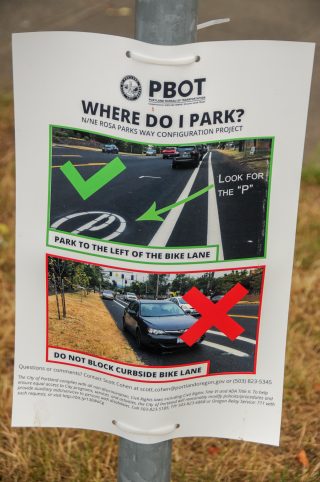
➤ What are you doing to encourage better parking compliance?
People are slowly getting better at parking away from the curb and out of the new bike lanes, but illegal parking is still common. Cohen would have liked the new parking signage and posts to all be installed simultaneously with the new striping; but that didn’t happen. He’s aware that people are still not parking their cars correctly and says he’s been in touch with Portland Parks to do more education with Peninsula Park visitors. PBOT plans to put up more of the 8.5 x 11-inch flyers that explain how to park and they have also called Parking Enforcement out to do extra patrols. “I think when the delineators [posts] come with parking signs on them, that will alleviate the issue.” The new signs are in the Maintenance Operations work order queue but Cohen wasn’t able to give us exact timeline.
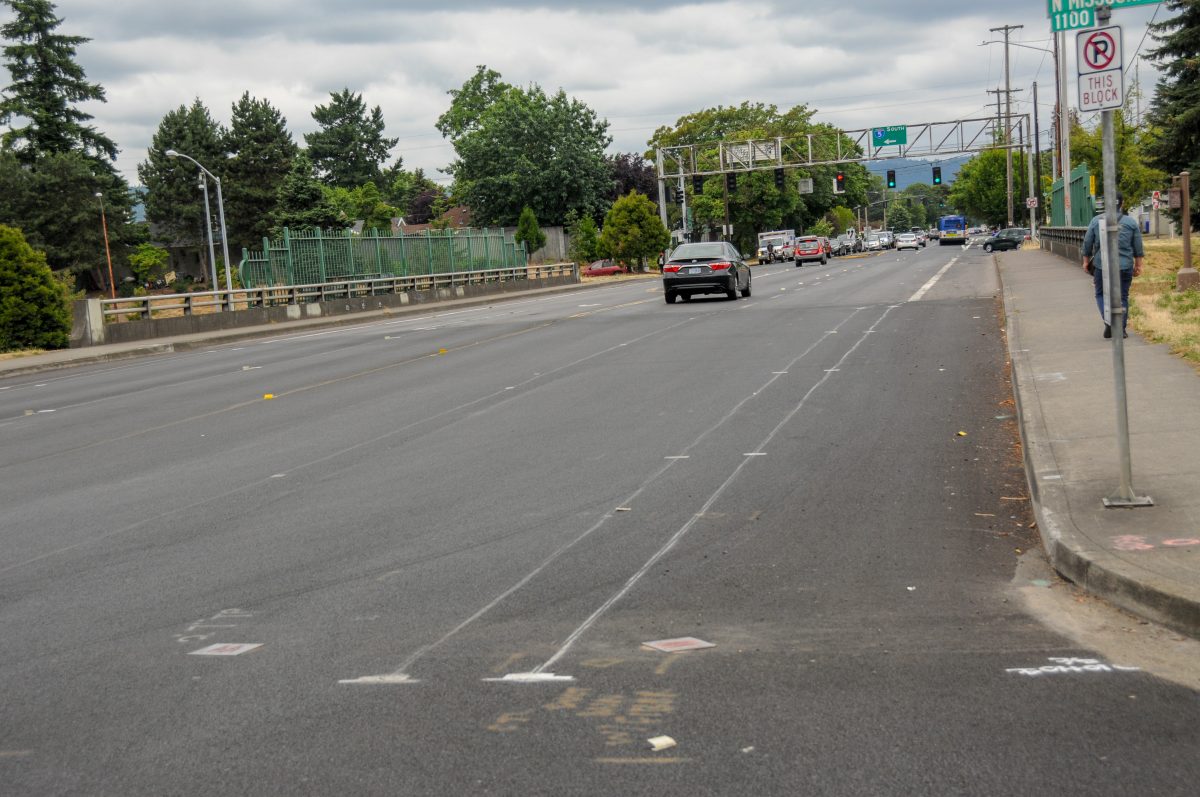
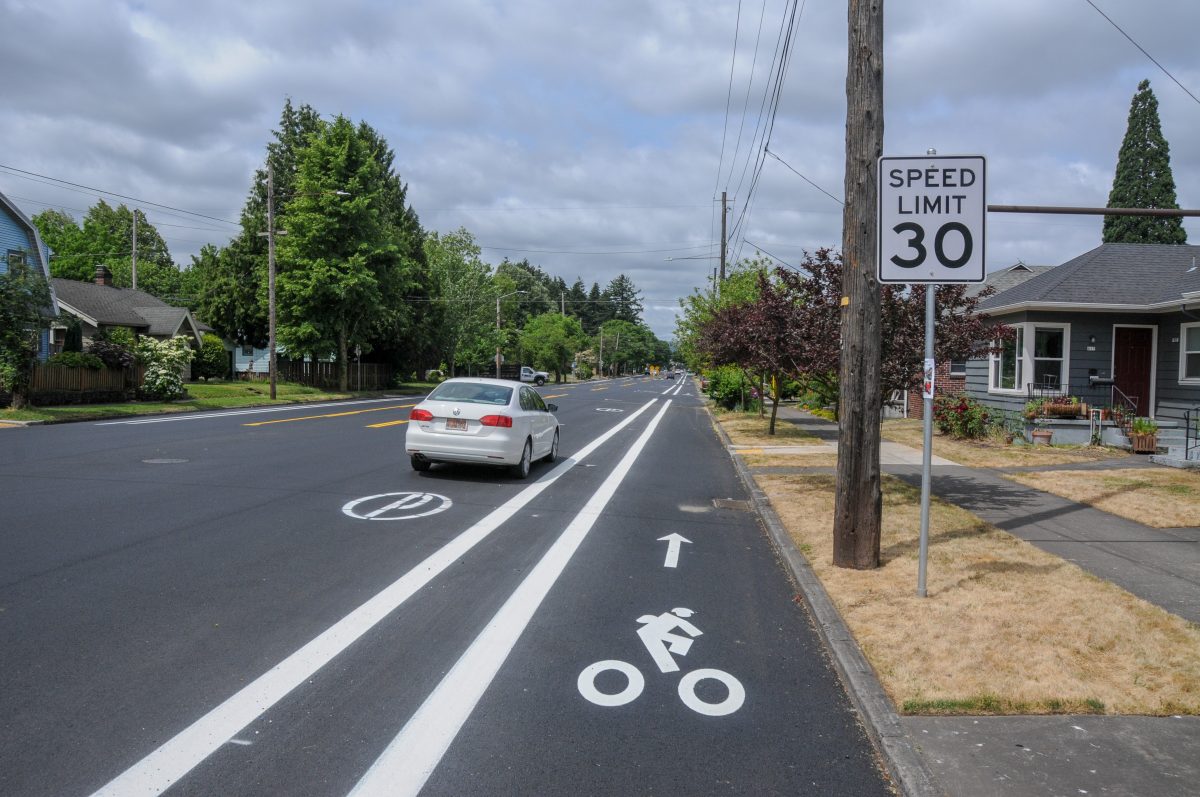
➤ Is the delayed roll-out of this project normal?
The short answer is No. Cohen admitted he’s learning lessons on-the-fly. Why? This project started as a repaving project and PBOT seized the opportunity to reconfigure the street and add the protected bike lane. It’s not a full-fledged capital project that would have set-aside engineering and planning funds, so it’s not being rolled-out with the usual budget or oversight. “This is a new endeavor for us to have new striping and signage over such a long corridor at once… it’s the first time we’ve done something of this magnitude that’s not a capital project… We bit off a big bite which is not typically what we do with a ‘missing links’ project [referring to a pot of money PBOT typically uses to fix small bikeway gaps] and we’re definitely learning some lessons,” Cohen explained. “Would I have preferred that everything [the parking signage and protective material] lined up right on top of the striping changes? Yes. But it didn’t play out that way.”
Rivera further added that what makes the Rosa Parks project different (and challenging) for PBOT is that it’s a “Very significant, big, safety improvement to the way the street is being used, and it’s being done in a very nimble way.” He also said parking-protected bike lanes are “relatively uncommon” for PBOT, especially in a residential neighborhood context. “There are only a couple other examples and they’re downtown or close-in. But here we are in a neighborhood in front of people’s homes on a key corridor miles from downtown, and we’re providing a really significant safety and comfort improvement for the bike facility without having to turn it into a 10-year, $6 million endeavor like a greenway project or something on that scale.”
In the end, Cohen (who lives in the neighborhood) and Rivera say they’re working as quickly as they can and the benefits will be worth the wait. “I understand peoples’ frustration. I would just let people know we are working on many levels as quickly as possible… hopefully next time we can do another safety project like this, the rollout will be smoother after this learning experience.”
Cohen will attend the Arbor Lodge Neighborhood Association meeting tonight to give an update on the project. Meeting details here.
— Jonathan Maus: (503) 706-8804, @jonathan_maus on Twitter and jonathan@bikeportland.org
Never miss a story. Sign-up for the daily BP Headlines email.
BikePortland needs your support.

